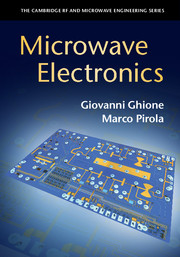Book contents
- Frontmatter
- Dedication
- Contents
- Preface
- Notation and Symbols
- 1 A System Introduction to Microwave Electronics
- 2 Passive Elements and Circuit Layout
- 3 CAD Techniques
- 4 Directional Couplers and Power Dividers
- 5 Active RF and Microwave Semiconductor Devices
- 6 Microwave Linear Amplifiers
- 7 Low-Noise Amplifier Design
- 8 Power Amplifiers
- 9 Microwave Measurements
- 10 CAD Projects
- Index
- References
2 - Passive Elements and Circuit Layout
Published online by Cambridge University Press: 10 November 2017
- Frontmatter
- Dedication
- Contents
- Preface
- Notation and Symbols
- 1 A System Introduction to Microwave Electronics
- 2 Passive Elements and Circuit Layout
- 3 CAD Techniques
- 4 Directional Couplers and Power Dividers
- 5 Active RF and Microwave Semiconductor Devices
- 6 Microwave Linear Amplifiers
- 7 Low-Noise Amplifier Design
- 8 Power Amplifiers
- 9 Microwave Measurements
- 10 CAD Projects
- Index
- References
Summary
Transmission Lines
Transmission lines (TXLs), simple or multiconductor, are a key distributed element in microwave circuits. They operate as signal transducers between components but are also the building block for passive distributed elements such as couplers, filters, matching sections, power dividers. In hybrid and monolithic microwave circuits the preferred guiding structures are the so-called TEM or quasi-TEM lines, characterized by broadband behavior and by the absence of a cutoff frequency, that is found in metal waveguides.
From a theoretical standpoint, N metal conductors with a ground plane support N TEM or quasi-TEM propagation modes. In TEM (Transverse ElectroMagnetic) modes, the electric and magnetic fields are transverse with respect to the propagation direction, i.e., orthogonal to the line axis. A purely TEM mode propagates in a line without conductor losses and with a homogeneous cross section, while lossy metal lines and lines with a non-homogeneous cross section support quasi-TEM modes with small longitudinal field components. An example of quasi-TEM line is the microstrip, where the cross section is partly filled by a dielectric, and partly by air. TEM and quasi-TEM lines may also support upper propagation modes with a cutoff frequency; however, the excitation of those modes is to be avoided because they contribute to radiation losses and coupling.
Transmission Line Theory
Transmission lines are a simple but convenient model for one-dimensional wave propagation, serving as a bridge between circuit theory and electromagnetics. Suppose first that the line is made of two lossless parallel conductors, one acting as the signal conductor, the other as the return or ground conductor, surrounded by a homogeneous, lossless medium. Such a structure supports a TEM propagation mode in which the electric and the magnetic fields lie in the line cross section and are orthogonal to the line axis and wave propagation direction; see Fig. 2.1 (a). In a TEM mode the transverse electric field can be derived from a potential function satisfying, in the line cross section, the Laplace equation. This is uniquely determined by the potential of the signal line v(z, t) with respect to the ground line, where the coordinate z is parallel to the line axis and propagation direction. The transverse magnetic field is in turn related to the total current i(z, t) flowing in the signal conductor; −i(z, t) flows instead in the return conductor.
- Type
- Chapter
- Information
- Microwave Electronics , pp. 28 - 86Publisher: Cambridge University PressPrint publication year: 2017



